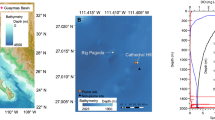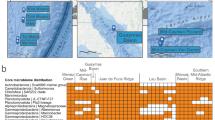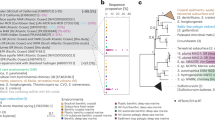Abstract
Microorganisms mediate geochemical processes in deep-sea hydrothermal vent plumes, which are a conduit for transfer of elements and energy from the subsurface to the oceans. Despite this important microbial influence on marine geochemistry, the ecology and activity of microbial communities in hydrothermal plumes is largely unexplored. Here, we use a coordinated metagenomic and metatranscriptomic approach to compare microbial communities in Guaymas Basin hydrothermal plumes to background waters above the plume and in the adjacent Carmen Basin. Despite marked increases in plume total RNA concentrations (3–4 times) and microbially mediated manganese oxidation rates (15–125 times), plume and background metatranscriptomes were dominated by the same groups of methanotrophs and chemolithoautotrophs. Abundant community members of Guaymas Basin seafloor environments (hydrothermal sediments and chimneys) were not prevalent in the plume metatranscriptome. De novo metagenomic assembly was used to reconstruct genomes of abundant populations, including Marine Group I archaea, Methylococcaceae, SAR324 Deltaproteobacteria and SUP05 Gammaproteobacteria. Mapping transcripts to these genomes revealed abundant expression of genes involved in the chemolithotrophic oxidation of ammonia (amo), methane (pmo) and sulfur (sox). Whereas amo and pmo gene transcripts were abundant in both plume and background, transcripts of sox genes for sulfur oxidation from SUP05 groups displayed a 10–20-fold increase in plumes. We conclude that the biogeochemistry of Guaymas Basin hydrothermal plumes is mediated by microorganisms that are derived from seawater rather than from seafloor hydrothermal environments such as chimneys or sediments, and that hydrothermal inputs serve as important electron donors for primary production in the deep Gulf of California.
Similar content being viewed by others
Log in or create a free account to read this content
Gain free access to this article, as well as selected content from this journal and more on nature.com
or
References
Agogue H, Brink M, Dinasquet J, Herndl GJ . (2008). Major gradients in putatively nitrifying and non-nitrifying Archaea in the deep North Atlantic. Nature 456: 788–791.
Anderson CR, Johnson HA, Caputo N, Davis RE, Torpey JW, Tebo BM . (2009). Mn(II) oxidation is catalyzed by heme peroxidases in ‘Aurantimonas manganoxydans’ strain SI85-9A1 and Erythrobacter sp. strain SD-21. Appl Environ Microbiol 75: 4130–4138.
Aristegui J, Gasol JM, Duarte CM, Herndl GJ . (2009). Microbial oceanography of the dark ocean's pelagic realm. Limnol Oceanogr 54: 1501–1529.
Baker BJ, Lesniewski RA, Dick GJ . (2012). Genome-enabled transcriptomics reveals archaeal populations that drive nitrification in a deep-sea hydrothermal plume. ISME J; e-pub ahead of print 14 June 2012; doi:10.1038/ismej.2012.64.
Baker ET, German CR, Elderfield H . (1995). Hydrothermal plumes over spreading-center axes: global distributions and geological inferences. In: Humphris SE, Zierenberg RA, Mullineaux LS, Thomson RE (eds). Seafloor Hydrothermal Systems: Physical, Chemical, Biological, and Geological Interactions. American Geophysical Union: Washington, DC, pp 47–71.
Bennett SA, Hansman RL, Sessions AL, Nakamura K, Edwards KJ . (2011a). Tracing iron-fueled microbial carbon production within the hydrothermal plume at the Loihi seamount. Geochemica et Cosmochimica Acta 75: 5526–5539.
Bennett SA, Statham PJ, Green DRH, Bris NL, McDermott JM, Prado F et al. (2011b). Dissolved and particulate organic carbon in hydrothermal plumes from the East Pacific Rise, 9°50'N. Deep-Sea Res I 58: 922–931.
Biddle JF, Cardman Z, Mendlovitz H, Albert DB, Lloyd KG, Boetius A et al. (2012). Anaerobic oxidation of methane at different temperature regimes in Guaymas Basin hydrothermal sediments. ISME J 6: 1018–1031.
Campbell AC, Gieskes JM, Lupton JE, Lonsdale PF . (1988). Manganese geochemistry in the Guaymas Basin, Gulf of California. Geochim Cosmochim Acta 52: 345–357.
Canfield DE, Stewart FJ, Thamdrup B, De Brabandere L, Dalsgaard T, Delong EF et al. (2010). A cryptic sulfur cycle in oxygen-minimum-zone waters off the Chilean coast. Science 330: 1375–1378.
Caron DA, Countway PD, Savai P, Gast RJ, Schnetzer A, Moorthi SD et al. (2009). Defining DNA-based operational taxonomic units for microbial-eukaryote ecology. Appl Environ Microbiol 75: 5797–5808.
Ciccarelli FD, Doerks T, von Mering C, Creevey CJ, Snel B, Bork P . (2006). Toward automatic reconstruction of a highly resolved tree of life. Science 311: 1283–1287.
Countway PD, Vigil PD, Schnetzer A, Moorthi SD, Caron DA . (2010). Seasonal analysis of protistan community structure and diversity at the USC Microbial Observatory (San Pedro Channel, North Pacific Ocean). Limnol Oceanogr 55: 2381–2396.
Cowen JP, Massoth GJ, Baker ET . (1986). Bacterial scavenging of Mn and Fe in a mid- to far-field hydrothermal particle plume. Nature 322: 169–171.
Cowen JP, Wen X, Popp BN . (2002). Methane in aging hydrothermal plumes. Geochim Cosmochim Acta 66: 3563–3571.
de Angelis MA, Lilley MD, Olson EJ, Baross JA . (1993). Methane oxidation in deep-sea hydrothermal plumes of the Endeavor Segment of the Juan de Fuca Ridge. Deep-Sea Res 40: 1169–1186.
DeLong EF, Preston CM, Mincer T, Rich V, Hallam SJ, Frigaard N-U et al. (2006). Community genomics among stratified microbial assemblages in the ocean's interior. Science 311: 496–503.
Dhillon A, Teske A, Dillon J, Stahl DA, Sogin ML . (2003). Molecular characterization of sulfate-reducing bacteria in the Guaymas Basin. Appl Environ Microbiol 69: 2765–2772.
Dick GJ, Lee YE, Tebo BM . (2006). Manganese(II)-oxidizing Bacillus spores in Guaymas Basin hydrothermal sediments and plumes. Appl Environ Microbiol 72: 3184–3190.
Dick GJ, Podell S, Johnson HA, Rivera-Espinoza Y, Bernier-Latmani R, McCarthy JK et al. (2008a). Genomic insights into Mn(II) oxidation by the marine alphaproteobacterium Aurantimonas sp. strain SI85-9A1. Appl Environ Microbiol 74: 2646–2658.
Dick GJ, Torpey JW, Beveridge TJ, Tebo BM . (2008b). Direct identification of a bacterial manganese(II) oxidase, the multicopper oxidase MnxG, from spores of several different marine Bacillus species. Appl Environ Microbiol 74: 1527–1534.
Dick GJ, Andersson AF, Baker BJ, Simmons SL, Thomas BC, Yelton AP et al. (2009a). Community-wide analysis of microbial genome sequence signatures. Genome Biol 10: R85.
Dick GJ, Clement BG, Fodrie FJ, Webb SM, Bargar JR, Tebo BM . (2009b). Enzymatic microbial Mn(II) oxidation and Mn biooxide production in the Guaymas Basin hydrothermal plume. Geochim Cosmochim Acta 73: 6517–6530.
Dick GJ, Tebo BM . (2010). Microbial diversity and biogeochemistry of the Guaymas Basin deep-sea hydrothermal plume. Environ Microbiol 12: 1334–1347.
Edgar RC . (2010). Search and clustering orders of magnitude faster than BLAST. Bioinformatics 26: 2460–2461.
Edgcomb VP, Kysela DT, Teske A, Gomez AD, Sogin ML . (2002). Benthic eukaryotic diversity in the Guaymas Basin hydrothermal vent environment. Proc Natl Acad Sci USA 99: 7658–7662.
Elderfield H, Schultz A . (1996). Mid-ocean ridge hydrothermal fluxes and the chemical composition of the ocean. Ann Rev Earth Planet Sci 24: 191–224.
Francis CA, Roberts KJ, Beman JM, Santoro AE, Oakley BB . (2005). Ubiquity and diversity of ammonia-oxidizing archaea in water columns and sediments of the ocean. Proc Natl Acad Sci USA 102: 14683–14688.
Frias-Lopez J, Shi Y, Tyson GW, Coleman ML, Schuster SC, Chisholm SW et al. (2008). Microbial community gene expression in ocean surface waters. Proc Natl Acad Sci USA 105: 3805–3810.
German CR, Bowen A, Coleman ML, Honig DL, Huber JA, Jakuba MV et al. (2010). Diverse styles of submarine venting on the ultraslow spreading Mid-Cayman Rise. Proc Natl Acad Sci USA 107: 14020–14025.
Griffiths-Jones S, Bateman A, Marshall M, Khanna A, Eddy SR . (2003). Rfam: an RNA family database. Nucleic Acids Res 31: 439–441.
Herndl GJ, Reinthaler T, Teira E, van Aken H, Veth C, Pernthaler A et al. (2005). Contribution of Archaea to total prokaryotic production in the deep Atlantic Ocean. Appl Environ Microbiol 71: 2303–2309.
Iverson V, Morris RM, Frazar CD, Berthiaume CT, Morales RL, Armbrust EV . (2012). Untangling genomes from metagenomes: revealing an uncultured class of marine Euryarchaeota. Science 335: 587–590.
Kadko D . (1993). An assessment of the effect of chemical scavenging within submarine hydrothermal plumes upon ocean geochemistry. Earth Planet Sci Lett 120: 361–374.
Karl DM, Knauer GA, Martin JH, Ward BB . (1984). Bacterial chemolithotrophy in the ocean is associated with sinking particles. Nature 309: 54–56.
Karner MB, DeLong EF, Karl DM . (2001). Archaeal dominance in the mesopelagic zone of the Pacific Ocean. Nature 409: 507–510.
Kessler JD, Valentine DL, Redmond MC, Du MR, Chan EW, Mendes SD et al. (2011). A persistent oxygen anomaly reveals the fate of spilled methane in the deep Gulf of Mexico. Science 331: 312–315.
Lam P, Cowen JP, Popp BN, Jones RD . (2008). Microbial ammonia oxidation and enhanced nitrogen cycling in the Endeavour hydrothermal plume. Geochim Cosmochim Acta 72: 2268–2286.
Lam TYP . (2004). Microbial ammonia oxidation in deep-sea hydrothermal plumes. University of Hawaii, Hawaii.
Lavik G, Stuhrmann T, Bruchert V, Van der Plas A, Mohrholz V, Lam P et al. (2009). Detoxification of sulphidic African shelf waters by blooming chemolithotrophs. Nature 457: 581–584.
Lizarralde D, Soule SA, Seewald JS, Proskurowski G . (2011). Carbon release by off-axis magmatism in a young sedimented spreading centre. Nat Geosci 4: 50–54.
Mandernack KW, Tebo BM . (1993). Manganese scavenging and oxidation at hydrothermal vents and in vent plumes. Geochim Cosmochim Acta 57: 3907–3923.
Martin-Cuadrado AB, Rodriguez-Valera F, Moreira D, Alba JC, Ivars-Martinez E, Henn MR et al. (2008). Hindsight in the relative abundance, metabolic potential and genome dynamics of uncultivated marine archaea from comparative metagenomic analyses of bathypelagic plankton of different oceanic regions. ISME J 2: 865–886.
McCollum TM . (2000). Geochemical constraints on primary productivity in submarine hydrothermal vent plumes. Deep-Sea Res 47: 85–101.
Meyer F, Paarmann D, D'Souza M, Olson R, Glass EM, Kubal M et al. (2008). The metagenomics RAST server—a public resource for the automatic phylogenetic and functional analysis of metagenomes. BMC Bioinform 9: 386.
Naganuma T, Elsaied HE, Hayashi T . (2004). Molecular analysis of deep-sea hydrothermal vent aerobic methanotrophs by targeting genes of 16S rRNA and particulate methane monooxygenase. Mar Biotechnol 6: 503–509.
Nakagawa S, Takai K, Inagaki F, Hirayama H, Nunoura T, Horikoshi K et al. (2005). Distribution, phylogenetic diversity and physiological characteristics of epsilon-proteobacteria in a deep-sea hydrothermal field. Environ Microbiol 7: 1619–1632.
Nakamura T, Hoaki T, Hanada S, Maruyama A, Kamagata Y, Fuse H . (2007). Soluble and particulate methane monooxygenase gene clusters in the marine methanotroph Methylomicrobium sp strain NI. FEMS Microbiol Lett 277: 157–164.
Newton IL, Woyke T, Auchtung TA, Dilly GF, Dutton RJ, Fisher MC et al. (2007). The Calyptogena magnifica chemoautotrophic symbiont genome. Science 315: 998–1000.
Pagé A, Tivey MK, Stakes DS, Reysenbach AL . (2008). Temporal and spatial archaeal colonization of hydrothermal vent deposits. Environ Microbiol 4: 874–884.
Pernthaler A, Preston CM, Pernthaler J, DeLong EF, Amann R . (2002). Comparison of fluorescently labeled oligonucleotide and polynucleotide probes for the detection of pelagic marine bacteria and archaea. Appl Environ Microbiol 68: 661–667.
Redmond MC, Valentine DL, Sessions AL . (2010). Identification of novel methane-, ethane-, and propane-oxidizing bacteria at marine hydrocarbon seeps by stable isotope probing. Appl Environ Microbiol 76: 6412–6422.
Reinthaler T, van Aken HM, Herndl GJ . (2010). Major contribution of autotrophy to microbial carbon cycling in the deep North Atlantic's interior. Deep-Sea Res Pt Ii 57: 1572–1580.
Sander SG, Koschinsky A . (2011). Metal flux from hydrothermal vents increased by organic complexation. Nat Geosci 4: 145–150.
Sauvadet AL, Gobet A, Guillou L . (2010). Comparative analysis between protist communities from the deep-sea pelagic ecosystem and specific deep hydrothermal habitats. Environ Microbiol 12: 2946–2964.
Schloss PD, Westcott SL, Ryabin T, Hall JR, Hartmann M, Hollister EB et al. (2009). Introducing mothur: open-source, platform-independent, community-supported software for describing and comparing microbial communities. Appl Environ Microbiol 75: 7537–7541.
Shi Y, Tyson GW, DeLong EF . (2009). Metatranscriptomics reveals unique microbial small RNAs in the ocean's water column. Nature 459: 266–269.
Shi Y, Tyson GW, Eppley JM, DeLong EF . (2011). Integrated metatranscriptomic and metagenomic analyses of stratified microbial assemblages in the open ocean. ISME J 5: 999–1013.
Stevens H, Ulloa O . (2008). Bacterial diversity in the oxygen minimum zone of the eastern tropical South Pacific. Environ Microbiol 10: 1244–1259.
Sunamura M, Higashi Y, Miyako C, Ishibashi J, Maruyama A . (2004). Two Bacteria phylotypes are predominant in the Suiyo Seamount hydrothermal plume. Appl Environ Microbiol 70: 1190–1198.
Suzuki MT, Preston CM, Beja O, de la Torre JR, Steward GF, DeLong EF . (2004). Phylogenetic screening of ribosomal RNA gene-containing clones in bacterial artificial chromosome (BAC) libraries from different depths in Monterey Bay. Microb Ecol 48: 473–488.
Swan BK, Martinez-Garcia M, Preston CM, Sczyrba A, Woyke T, Lamy D et al. (2011). Potential for chemolithoautotrophy among ubiquitous bacteria lineages in the dark ocean. Science 333: 1296–12300.
Tagliabue A, Bopp L, Dutay JC, Bowie AR, Chever F, Jean-Baptiste P et al. (2010). Hydrothermal contribution to the oceanic dissolved iron inventory. Nat Geosci 3: 252–256.
Takai K, Oida H, Suzuki Y, Hirayama H, Nakagawa S, Nunoura T et al. (2004). Spatial distribution of marine crenarchaeota group I in the vicinity of deep-sea hydrothermal systems. Appl Environ Microbiol 70: 2404–2413.
Tavormina PL, Ussler W, Joye SB, Harrison BK, Orphan VJ . (2010). Distributions of putative aerobic methanotrophs in diverse pelagic marine environments. ISME J 4: 700–710.
Tebo BM, Bargar JR, Clement BG, Dick GJ, Murray KJ, Parker D et al. (2004). Biogenic manganese oxides: properties and mechanisms of formation. Ann Rev Earth Planet Sci 32: 287–328.
Teske A, Hinrichs K-U, Edgcomb V, Gomez A, Kysela D, Sylva SP et al. (2002). Microbial diversity of hydrothermal sediments in the Guaymas Basin: evidence for anaerobic methanotrophic communities. Appl Environ Microbiol 68: 1994–2007.
Toner BM, Fakra SC, Manganini SJ, Santelli CM, Marcus MA, Moffett JW et al. (2009). Preservation of iron(II) by carbon-rich matrices in a hydrothermal plume. Nat Geosci 2: 197–201.
Von Damm KL, Edmond JM, Measures CI, Grant B . (1985). Chemistry of submarine hydrothermal solutions at Guaymas Basin, Gulf of California. Geochim Cosmochim Acta 49: 2221–2237.
Walker CB, de la Torre JR, Klotz MG, Urakawa H, Pinel N, Arp DJ et al. (2010). Nitrosopumilus maritimus genome reveals unique mechanisms for nitrification and autotrophy in globally distributed marine crenarchaea. Proc Natl Acad Sci USA 107: 8818–8823.
Walsh DA, Zaikova E, Howes CG, Song YC, Wright JJ, Tringe SG et al. (2009). Metagenome of a versatile chemolithoautotroph from expanding oceanic dead zones. Science 326: 578–582.
Winn CD, Karl DM, Massoth GJ . (1986). Microorganisms in deep-sea hydrothermal plumes. Nature 320: 744–746.
Yooseph S, Sutton G, Rusch DB, Halpern AL, Williamson SJ, Remington K et al. (2007). The Sorcerer II Global Ocean Sampling expedition: expanding the universe of protein families. PLoS Biol 5: e16.
Zhu YL, Li Y, Pulukkunat DK . (2007). Deciphering RNA structural diversity and systematic phylogeny from microbial metagenomes. Nucleic Acids Res 35: 2283–2294.
Acknowledgements
We thank Bradley M Tebo for providing the samples that were used in this study. This project is funded in part by the Gordon and Betty Moore Foundation and the National Science Foundation (OCE 1029242). We also thank the University of Michigan Rackham Graduate School Faculty Research Fellowship Program for their support and Kathryn Iverson for assistance with bioinformatic analyses. DNA and cDNA sequencing was conducted in the laboratory of Stephan Schuster at Penn State University with the kind assistance of Lynn Tomsho. Cody Sheik, Meng Li and Brett Baker provided helpful comments and revisions to the manuscript.
Author information
Authors and Affiliations
Corresponding author
Additional information
Supplementary Information accompanies the paper on The ISME Journal website
Supplementary information
Rights and permissions
About this article
Cite this article
Lesniewski, R., Jain, S., Anantharaman, K. et al. The metatranscriptome of a deep-sea hydrothermal plume is dominated by water column methanotrophs and lithotrophs. ISME J 6, 2257–2268 (2012). https://doi.org/10.1038/ismej.2012.63
Received:
Revised:
Accepted:
Published:
Issue date:
DOI: https://doi.org/10.1038/ismej.2012.63
Keywords
This article is cited by
-
Impact of high Fe-concentrations on microbial community structure and dissolved organics in hydrothermal plumes: an experimental study
Scientific Reports (2022)
-
Niche differentiation of sulfur-oxidizing bacteria (SUP05) in submarine hydrothermal plumes
The ISME Journal (2022)
-
Metagenomic analysis reveals wide distribution of phototrophic bacteria in hydrothermal vents on the ultraslow-spreading Southwest Indian Ridge
Marine Life Science & Technology (2022)
-
Gammaproteobacteria mediating utilization of methyl-, sulfur- and petroleum organic compounds in deep ocean hydrothermal plumes
The ISME Journal (2020)
-
The oxidation of hydrocarbons by diverse heterotrophic and mixotrophic bacteria that inhabit deep-sea hydrothermal ecosystems
The ISME Journal (2020)



